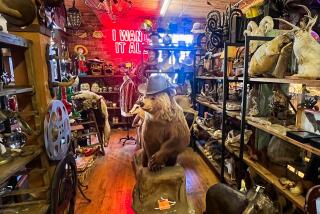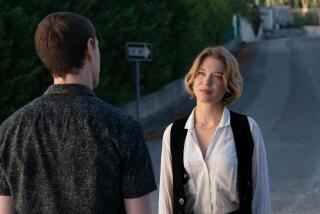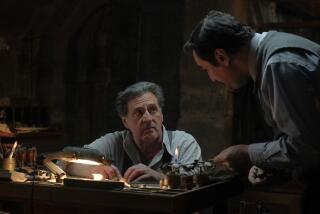How ‘Fantastic Beasts: The Crimes of Grindelwald’ made an even more magical Paris
More than a year ago, a vast reconstruction of 1920s Paris emerged on the backlot of Warner Bros. Leavesden just outside London.
At the time, fans didn’t know that J.K. Rowling would take them to the French capital in “Fantastic Beasts: The Crimes of Grindelwald,” which opens in the U.S. on Nov. 16, but the actors and director David Yates were able to immerse themselves in the story using a series of magical Parisian streets and shops. Although the sequel to 2016’s “Fantastic Beasts and Where to Find Them” also brings the audience to New York and London, Paris is the focal point for the new adventures of Newt Scamander (Eddie Redmayne).
To re-create Paris in 1927, three-time Oscar-winning production designer Stuart Craig and his team took several trips to the city, photographing references and exploring some of the specific places Rowling noted in her script. They also hired a full-time researcher, who complied an archive of period photographs.
FULL COVERAGE: 2018 Holiday movie preview »
Craig’s version of Paris brings together elements of Baron Haussmann, an architect who renovated Paris in the 19th century, and pulls in the neighborhoods of the Marais, Pigalle and Montmartre. The entrance to magical Paris in Montmartre is at the base of a lively bronze statue, based off a real statue in Paris’ Opéra house. The realistic flourishes bring a desired sense of authenticity to the fantasy realm.
“The approach that we’ve used on the Potter films and these films is to make every place look real and then use magic to come out of that seeming reality,” says Craig, who has been the visual mastermind behind every Rowling film adaptation, earning Oscar nominations on four of them, along with one for the first “Fantastic Beasts.” “That was our aim: to make Paris look, at first glance, completely real. The magic is largely hidden and appears when it needs to.”
The French ministry of magic, known as the Ministére des Affaires Magique, draws its inspiration from the Palais-Royal. Rowling specified in the script that the building would be art nouveau in style, and Craig delivered by using curving, twirling designs and a series of interconnected domes.
“Art nouveau was the height of fashion and taste and architecture interest,” Craig notes. “Inside [the ministry], there’s a typing pool, and above that is this massive dome, and etched onto the ceiling are these creatures in star patterns, like the zodiac. Ours are new constellations in the shape of these magical creatures.”
He adds, “It’s nice to have a French ministry, U.S ministry and a British ministry — and probably in the third film, a Berlin-based ministry. They’re all variations on a theme, and that’s very nice to deal with as a designer.”
The typing pool is made up of about 100 extras, which meant that the props team had to manufacture more than 100 circular period typewriters (some of the more than 100,000 props created for the picture), which were copied from a 1910 typing keyboard.
To arrive in the Ministére, wizards journey to the Place de Furstenberg, a real square in Paris’ 6th arrondissement, where an elevator emerges from four trees. The Place was replicated on the backlot at Leavesden, along with several magical streets and the home of Nicolas Flamel (a name most associated in Potter-lore with the sorcerer’s stone), which draws on a Tudor design to suggest his ancient years.
The backlot was built with green screens above each building to allow the visual effects team to expand on practical sets during post-production.
“Having something tangible there that we extend just looks better,” says visual effects supervisor Christian Manz. “It’s something the actors can be in, to understand the world that they’re in. The Paris set is big. It’s not as big as Paris, but the actors are still walking around streets. You really do feel they’re in that place. What we create beyond that hopefully just adds to [the location].”
The climax of this chapter in the story takes the characters to Père Lachaise, the largest cemetery in Paris, which Craig and his team remade — in part — in a studio at Leavesden. They also partially built a giant underground amphitheater that fit more than 600 extras.
“It’s very photogenic,” Craig says of the cemetery. “The tombs are quite elaborate and stretch all the way from the front gate up this big hill. It’s good inspiration for the bit we built in Leavesden in the studio.”
Longtime fans will find a sort of visual continuity among all the Potter films, even as the narrative shifts to new countries.
“It’s Stuart’s vision of the world,” notes visual effects supervisor Tim Burke. “He created the world for Potter, which grounded it in a reality that made it believable. We don’t want it to become science fiction, because we’ve got to believe this world exists. If it’s grounded, then you believe the magic. Everything just looks real.”

The cast of the “Harry Potter” spin-off film talk about returning for the sequel, “Fantastic Beasts: The Crimes of Grindelwald.”
More to Read
Only good movies
Get the Indie Focus newsletter, Mark Olsen's weekly guide to the world of cinema.
You may occasionally receive promotional content from the Los Angeles Times.






